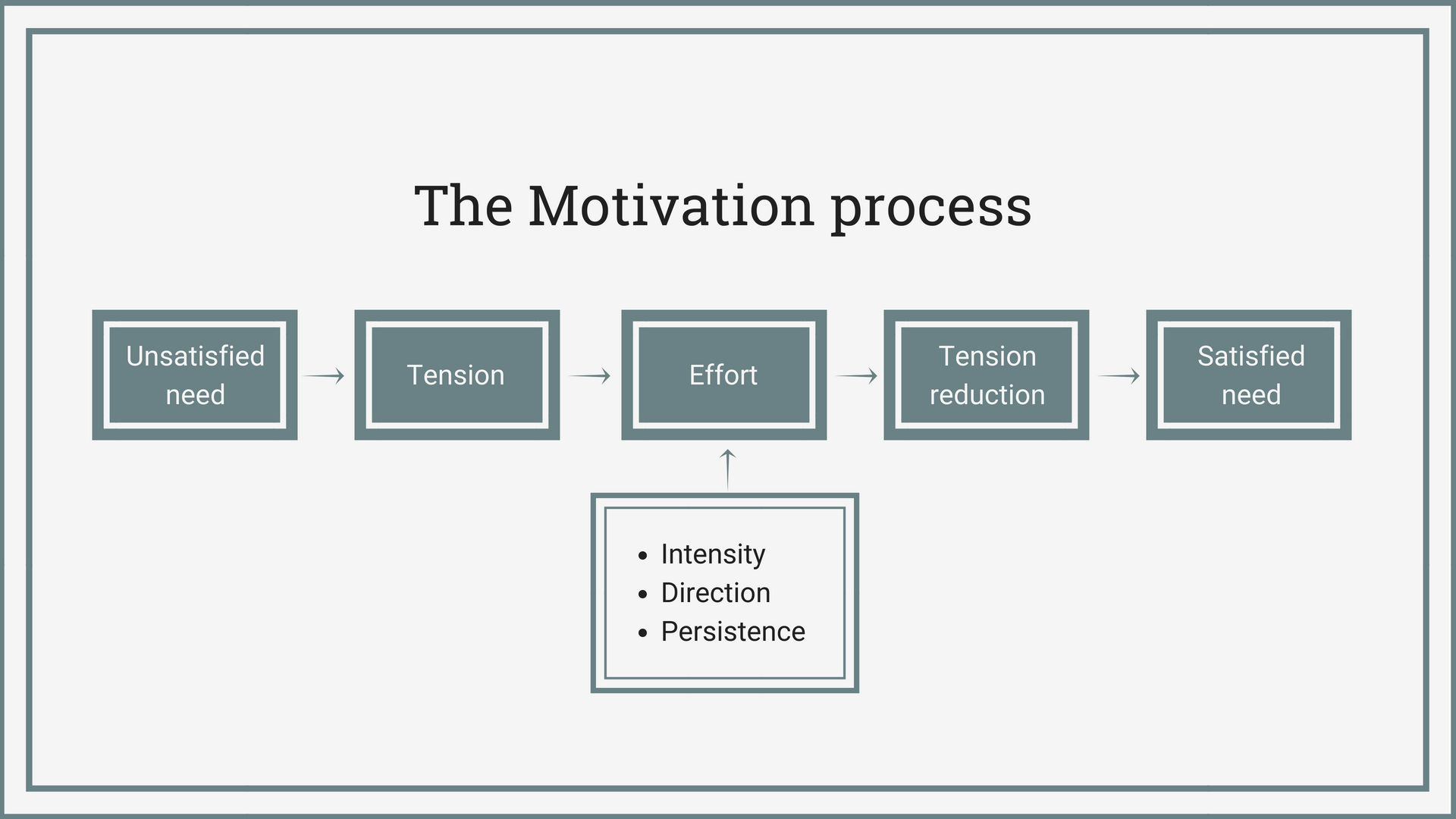Anyone who has ever wanted to lose weight, get in better shape, eat healthier or adopt a better lifestyle knows firsthand just how important motivation is. Because it takes more, a whole lot more than merely wanting something. Reaching that goal is often so daunting that many just quit.
Yet there are numerous objectives in each of our lives and fulfilling them is not always optional – for most of us having a job that pays enough so that we can pay rent, bills and buy food is compulsory for survival (or for not being forced to live with our parents forever and that’s pretty much the same thing).
Motivational psychology in the workplace
Based on this handy SlideShare presentation on employee motivation and business psychology, the motivational process looks something like this:

Many people give up once they hit the ‘effort’ stage because even if it is directed towards getting something they want, effort has the nasty habit of being hard, frustrating and exhausting.
This leaves HR professionals with a complicated puzzle to solve: how to motivate employees while keeping business goals in mind, making sure that the first are content and the latter attained.
Inspire, don’t train
If L&D managers don’t really understand what motivates the employees, all training interventions become mere shots in the dark. Some may stick and inspire but that will occur by accident only.
To make matters even more complicated, all previous research on motivational psychology is rendered more or less useless by the younger generations. Raised in a completely different environment than their predecessors, they come with a new (and more flexible) set of values, a very low degree of conformity and a strong set of personal beliefs.
Read more: Top 3 ways to meet Millennials training needs
It’s paramount that L&D professionals understand that this new generation, the one that makes up most of the workforce today has unlimited and unhindered access to content. If they want to learn about space, they can do so from Stephen Hawking. If they want to learn how to make haggis, Gordon Ramsay will demonstrate in short and comprehensive video. If they are interested in the principles of marketing, Alvin Toffler is there to enumerate them at any time.
Today’s trainers and e-learning designers don’t really teach content, they facilitate an experience for people. If that experience is a positive one, it will drive behavior. If it isn’t it will just waste time, money and effort.
Traditional training is meant to teach skills and develop competencies through instruction and practice over a period of time. That no longer suffices. Facilitation is aimed at making actions or processes simpler (and, if at all possible, fun) by assisting the learner in the process.
Successful leaders and facilitators manage to inspire.
Master the motivational theories
Being inspired is a deeply personal thing. We all have models, some in our family, some in books, on TV and perhaps even in comic books (those superheroes are just too great to ignore). As Simon Sinek pointed out, Martin Luther King remained in history with his “I have a dream” speech not “I have plan” one.
For business people, used to charts, graphs and numbers this may seem well in the realm of scary, unquantifiable, hard to define mumbo-jumbo.
There are many theories of motivation. First there’s Maslow’s enduring (yet often contested) pyramid.
Then there are Theory X and Theory Y, created and developed by Douglas McGregor at the MIT Sloan School of Management in the 1960s .They describe two contrasting models of workforce motivation. The first one postulates that people are inherently lazy, irrational and unreliable so they need to be controlled and motivated either by incentives or threats. Theory Y regards people as moral responsible beings who seek independence, self-development and creativity in their work.
And then there is Herzberg’s Motivation-Hygiene Theory. He says that people’s motivation at work is influenced by two sets of factors: 1) motivator factors (like achievement, recognition, the work itself, responsibility, advancement, growth) and 2) hygiene factors (like work conditions, salary, status, security). The second type of factors can demotivate employees if they’re not present, but would not actually motivate them to work harder if they are present. Employees can therefore be influenced to work harder by interesting work but they can become demotivated if they work under poor working conditions with low pay.
Make it personal
While Herzberg’s model may prove very alluring to HR professionals as it provides certain recipes for what to do or what to fix in order to motivate employees, it has the same fault as all “one size fits all” concepts – it does not work well for everybody.
In order to figure out what makes employees tick, what they want, what they dislike and most importantly why they chose to work for a particular organization, HR specialists have to ask them.
With everything from wristwatches to homes being personalized and adapted to individual needs, it’s rather odd to keep motivation models and practices stuck in charts or demographics. All the factors mentioned by Herzberg are completely valid but in order for them to function it’s necessary to know which applies to whom.
All in all
Far from being an exact science, motivational psychology is all about uncovering people’s reasons for doing things and transforming them in a way that can drive people to behave in a certain way. The key is to take the time and pick a personalized motivational pattern, one that will have the buy-in of its recipient.







